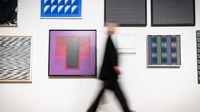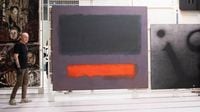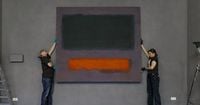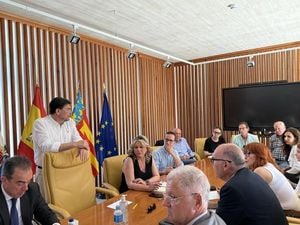A child has damaged a painting by Mark Rothko, valued at up to 50 million euros, in a museum in Rotterdam, Netherlands. The incident has raised questions about security measures and the responsibility for restoration costs.
The artwork, titled "Grey, Orange on Maroon, No. 8," was on display in a publicly accessible depot building adjacent to the Museum Boijmans Van Beuningen. The museum confirmed that the damage occurred during an "unattended moment," as reported by the Dutch newspaper Algemeen Dagblad and the BBC.
According to a museum spokesperson, the damage consists of "superficial scratches" visible in the unpainted layer of paint on the lower part of the painting. The museum is currently seeking experts to assess the damage and determine the necessary steps for restoration. Despite the incident, officials remain optimistic that the artwork will be displayed again in the future.
The museum, which has been closed for renovations until at least 2030, has a history of charging visitors for damages caused to artworks in similar incidents. It is unclear whether the child's family will be held responsible for the restoration costs, which are expected to be significant given the complexity involved in restoring Rothko's works.
Mark Rothko, born in 1903 in present-day Latvia, is known for his contributions to abstract expressionism and color field painting. His works are characterized by large, vibrant color blocks that evoke deep emotional responses. Rothko passed away in 1970, and his painting "Grey, Orange on Maroon, No. 8" was acquired by the museum in the same year.
The incident in Rotterdam is not the first time a Rothko painting has faced damage. In 2012, a Rothko piece in the Tate Modern was vandalized with graffiti, leading to a lengthy and costly restoration process. The perpetrator of that incident received a two-year prison sentence.
Experts in art restoration, such as Jonny Helm from the UK-based Plowden & Smith, have noted that modern, unsealed paintings like Rothko's are particularly vulnerable to damage. "Even the smallest scratch is immediately visible," Helm explained, emphasizing the challenges faced by restorers when working with Rothko's unique mixture of pigments, resins, and adhesives.
This recent event has sparked discussions about the security of valuable artworks in museums. In Austria, for instance, masterpieces are typically displayed behind glass or in specially secured vitrines, with constant monitoring by trained personnel and camera systems. Following incidents like this, museums worldwide often implement additional protective measures, such as increasing the distance between visitors and artworks, installing physical barriers, and enhancing the presence of supervisory staff.
As the Museum Boijmans Van Beuningen navigates this incident, it must balance the need for public access to art with the imperative of protecting valuable pieces. The museum is currently deliberating on the next steps for the painting, while also considering how this incident may affect future policies regarding public access to art collections.
In light of the damage, the museum has not released the age of the child responsible for the incident, but it has confirmed that they are aware of the family's identity. This adds another layer of complexity to the situation, as discussions about liability and responsibility for the costs of restoration continue.
The museum's commitment to restoring the painting reflects a broader trend in the art world, where institutions strive to preserve and protect cultural heritage while also making art accessible to the public. As debates about security and accessibility continue, the Rotterdam incident serves as a reminder of the delicate balance that museums must maintain.
As the story unfolds, many are left wondering: Will the Rothko painting be restored to its former glory? And what lessons will museums learn from this incident to better protect their collections in the future?
This news was broadcast on Deutschlandfunk on April 29, 2025, highlighting the ongoing discussions surrounding art preservation and public engagement with cultural institutions.






